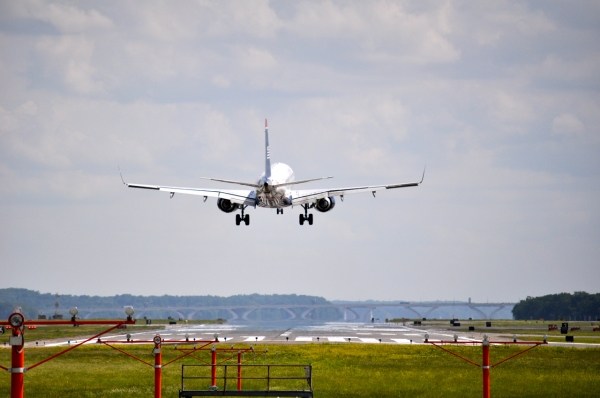Three Square Miles of Concrete
This is the second article in our series on U.S. infrastructure, following the introductory article. The American Society of Civil Engineers (ASCE) assigned the United States’ AVIATION infrastructure a grade of “D” on their 2009 Report Card for America’s Infrastructure.

U.S. Infrastructure Series
U.S. Infrastructure - Obvious But Unnoticed
A Bridge To Everywhere
It's About Dam Time!
We Might Have A Drinking Problem
Most people will be shocked to learn that there are 19,959 locations in the United States established to land aircraft. That might be more than most folks imagine. The more curious can review their home state’s listings. Many of these are heliports and/or privately owned facilities.
Of those that are hard-surfaced landing areas with runways and installed systems capable of supporting airlines, only 522 of these nearly 20,000 facilities support over 99.88% of the United States’ commercial scheduled carrier services (this does not include charter or business flights). From within this group of 522, the top ten U.S. airports, based on total passenger volume, are Atlanta Hartsfield (ATL), Chicago O’Hare (ORD), Los Angeles International (LAX), Dallas-Fort Worth (DFW), Denver International (DIA), New York John F. Kennedy (JFK), Las Vegas McCarran (LAS), Phoenix Sky Harbor (PHX), Houston Bush (IAH), and Newark, NJ Liberty (EWR). Such is the data found on the aviation page of ASCE’s 2009 Report Card for America’s Infrastructure.
If the idea that 522 airport facilities support 99.88% of the United States’ scheduled carrier service is not fascinating, here is a follow-on twist that I researched using the federal government’s Bureau of Transportation Statistics (BTS) data: the top ten airports listed above support 32% of the United States’ annual scheduled-carrier passenger volume. I used the 2008 data for originating passengers bound for both U.S. and international destinations to support this assessment.
Ten airports are supporting one third of the scheduled carrier passengers! Now we get to the really geeky part that you’ll only find on Buildipedia.com. The combined lengths of all usable runways at these ten airports is less than 100 miles. It is 96.7 miles, according to my assessment. This is the approximate driving distance from Baltimore to Philadelphia. That’s not very far, particularly relative to the incredible expanse of concrete in our highway systems by comparison. Let’s take it a step further. The average width of these runways is just over 150 feet. Now we can determine that 32% of the United States’ annual scheduled carrier passengers are supported by less than 3 square miles of concrete at only 10 metropolitan airport facilities, hence the title of this article.
Now, if you are asking “Why does this matter?”, my point is simply that the most significant shortcomings of the U.S. aviation system are not related to tangible construction projects in the traditional sense of concrete, steel, buildings, and paving. After all, with only 3 square miles of pavement supporting one third of our aviation traffic, it’s hard to blame too many issues on the runway environment. Sure, the airport that’s been waiting for a new runway for 10 years will have issues with such a generalization from me. But, in terms of the nationwide U.S. aviation infrastructure, the flow of traffic on and off the runways is really the fertile ground for major system improvements, not the actual physical facilities.
Why did the ASCE assign a letter grade of a “D” to aviation infrastructure during their most recent evaluation in 2009? What areas are most deficient that require attention? These questions must figure prominently in the minds of those seeing such a low grade assigned to our aviation infrastructure. My immediate thought is that our airports don’t seem to be in that bad of shape, especially given that I just framed them as not being the linchpin to our current problems. Last year I had the pleasure of flying out of Denver International (DIA) and Phoenix Sky Harbor (PHX), both on our top ten list. Any firm, bumpy, or otherwise uncomfortable landings experienced there could not be blamed on the runways! Additionally, the terminals themselves (if one has to hang out in them for 12 hours a day) are not bad at all. DIA in particular is quite impressive in layout and construction quality, both with respect to the runways and terminal area. It’s also the only place I’ve ever seen a civil engineer (the guy who envisioned it and planned it) celebrated with a statue in his honor.
In my opinion, there are two significant primary reasons for the “D” grade in our aviation infrastructure. First, and least of the two, is a lack of capability to expand or adjust facilities quickly, where needed. This could include a runway extension, installation of new navigation equipment, or enhancing the passenger support characteristics of a terminal complex. These shortcomings are more related to bureaucracy and funding than to any type of technical construction challenges.
The second major reason for a low score is the big one that’s unseen by passengers (except as manifested in the form of schedule delays, of course): the electronic/computer capacity of the air traffic control system to process and handle flights. Anyone who’s been on a business trip or vacation when a FAA computer glitch occurs, or a major storm system erupts, understands this challenge all too well.
The FAA has plans to address this second issue with their “Next Generation” or “NextGen” program. In a nutshell, NextGen will transition the entire National Airspace System (NAS) from one served by ground based computers and radars to one based on satellite navigation and airborne aircraft control systems. The current NAS is largely an unseen, electronically defined highway, which still requires flying along the established airways in a consistent and repeatable fashion each day. NextGen will allow for more frequent direct-routing of flights from departure to destination. Another enhancement offered by NextGen will be that the departure and arrival profiles available to each aircraft will be based on a combination of aircraft performance, weather, and adjacent air traffic, in a dynamic environment that is adjustable from one day to the next. The current system is not nearly that flexible, and largely requires compliance with canned procedures regardless of these outside dynamic factors.
The net result of all this is that the new NAS will be able to accommodate a larger volume of air traffic flow more efficiently, and hopefully improve future aviation infrastructure grades from a “D” to a much higher grade.
As with any government endeavor, critics may point to flaws in the scope, procurement plans, and timelines envisioned for NextGen. Some of their points may be completely legitimate. I don’t want to take on those critics. I just know that improvements to traffic flow and routing are where the greatest changes to our NAS are necessary. NextGen tries to tackle those issues, so at least we are moving in the right direction, to whatever extent programmatic flaws may exist.
Join us next time for “A Bridge to Everywhere,” when Buildipedia.com addresses bridges, the next alphabetical infrastructure component in ASCE’s 2009 Report Card for America’s Infrastructure.

Andrew Kimos
Andrew Kimos completed the civil engineering programs at the U.S. Coast Guard Academy (B.S. 1987) and the University of Illinois (M.S. 1992) and is a registered Professional Engineer in the state of Wisconsin. He served as a design engineer, construction project manager, facilities engineer, and executive leader in the Coast Guard for over 20 years. He worked as a regional airline pilot in the western U.S. before joining the Buildipedia.com team as Operations Channel Producer.
Website: buildipedia.com/channels/operations




